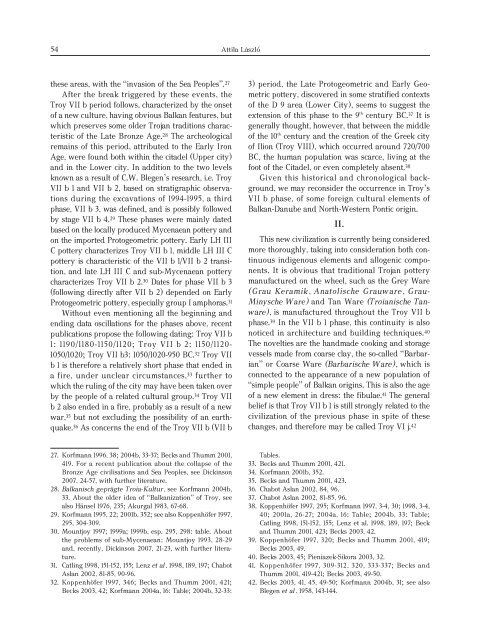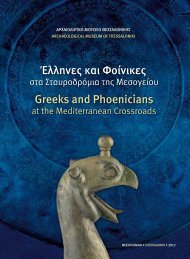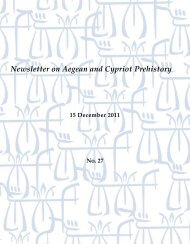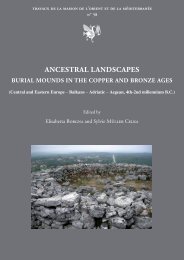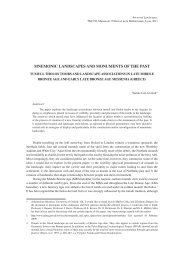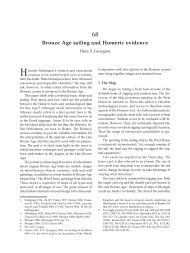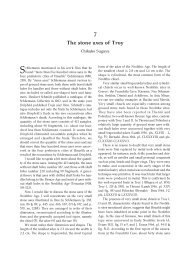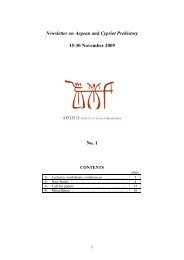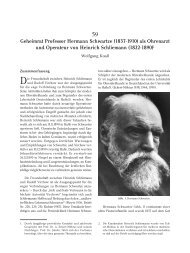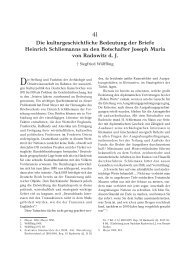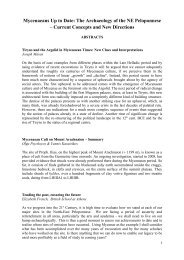54 Attila La′szlόthese areas, with the “invasion of the Sea Peoples”. 27After the break triggered by these events, theTroy VII b period follows, characterized by the onsetof a new culture, having obvious Balkan features, butwhich preserves some older Trojan traditions characteristicof the Late Bronze Age. 28 The archeologicalremains of this period, attributed to the Early IronAge, were found both within the citadel (Upper city)<strong>and</strong> in the Lower city. In addition to the two levelsknown as a result of C.W. Blegen’s research, i.e. TroyVII b 1 <strong>and</strong> VII b 2, based on stratigraphic observationsduring the excavations of 1994-1995, a thirdphase, VII b 3, was defined, <strong>and</strong> is possibly followedby stage VII b 4. 29 These phases were mainly datedbased on the locally produced Mycenaean pottery <strong>and</strong>on the imported Protogeometric pottery. Early LH IIIC pottery characterizes Troy VII b 1, middle LH III Cpottery is characteristic of the VII b 1/VII b 2 transition,<strong>and</strong> late LH III C <strong>and</strong> sub-Mycenaean potterycharacterizes Troy VII b 2. 30 Dates for phase VII b 3(following directly after VII b 2) depended on EarlyProtogeometric pottery, especially group I amphoras. 31Without even mentioning all the beginning <strong>and</strong>ending data oscillations for the phases above, recentpublications propose the following dating: Troy VII b1: 1190/1180-1150/1120; Troy VII b 2: 1150/1120-1050/1020; Troy VII b3: 1050/1020-950 BC. 32 Troy VIIb 1 is therefore a relatively short phase that ended ina fire, under unclear circumstances, 33 further towhich the ruling of the city may have been taken overby the people of a related cultural group. 34 Troy VIIb 2 also ended in a fire, probably as a result of a newwar, 35 but not excluding the possibility of an earthquake.36 As concerns the end of the Troy VII b (VII b3) period, the Late Protogeometric <strong>and</strong> Early Geometricpottery, discovered in some stratified contextsof the D 9 area (Lower City), seems to suggest theextension of this phase to the 9 th century BC. 37 It isgenerally thought, however, that between the middleof the 10 th century <strong>and</strong> the creation of the Greek cityof Ilion (Troy VIII), which occurred around 720/700BC, the human population was scarce, living at thefoot of the Citadel, or even completely absent. 38Given this historical <strong>and</strong> chronological background,we may reconsider the occurrence in Troy’sVII b phase, of some foreign cultural elements ofBalkan-Danube <strong>and</strong> North-Western Pontic origin.II.This new civilization is currently being consideredmore thoroughly, taking into consideration both continuousindigenous elements <strong>and</strong> allogenic components.It is obvious that traditional Trojan potterymanufactured on the wheel, such as the Grey Ware(Grau Keramik, Anatolische Grauware, Grau-Minysche Ware) <strong>and</strong> Tan Ware (Troianische Tanware),is manufactured throughout the Troy VII bphase. 39 In the VII b 1 phase, this continuity is alsonoticed in architecture <strong>and</strong> building techniques. 40The novelties are the h<strong>and</strong>made cooking <strong>and</strong> storagevessels made from coarse clay, the so-called “Barbarian”or Coarse Ware (Barbarische Ware), which isconnected to the appearance of a new population of“simple people” of Balkan origins. This is also the ageof a new element in dress: the fibulae. 41 The generalbelief is that Troy VII b 1 is still strongly related to thecivilization of the previous phase in spite of thesechanges, <strong>and</strong> therefore may be called Troy VI j. 4227. Korfmann 1996, 38; 2004b, 33-37; Becks <strong>and</strong> Thumm 2001,419. For a recent publication about the collapse of theBronze Age civilisations <strong>and</strong> Sea Peoples, see Dickinson2007, 24-57, with further literature.28. Balkanisch geprägte Troia-Kultur, see Korfmann 2004b,33. About the older idea of “Balkanization” of Troy, seealso Hänsel 1976, 235; Akurgal 1983, 67-68.29. Korfmann 1995, 22; 2001b, 352; see also Koppenhöfer 1997,295, 304-309.30. Mountjoy 1997; 1999a; 1999b, esp. 295, 298: table. Aboutthe problems of sub-Mycenaean: Mountjoy 1993, 28-29<strong>and</strong>, recently, Dickinson 2007, 21-23, with further literature.31. Catling 1998, 151-152, 155; Lenz et al. 1998, 189, 197; ChabotAslan 2002, 81-85, 90-96.32. Koppenhöfer 1997, 346; Becks <strong>and</strong> Thumm 2001, 421;Becks 2003, 42; Korfmann 2004a, 16: Table; 2004b, 32-33:Tables.33. Becks <strong>and</strong> Thumm 2001, 421.34. Korfmann 2001b, 352.35. Becks <strong>and</strong> Thumm 2001, 423.36. Chabot Aslan 2002, 84, 96.37. Chabot Aslan 2002, 81-85, 96.38. Koppenhöfer 1997, 295; Korfmann 1997, 3-4, 30; 1998, 3-4,40; 2001a, 26-27; 2004a, 16: Table; 2004b, 33: Table;Catling 1998, 151-152, 155; Lenz et al. 1998, 189, 197; Beck<strong>and</strong> Thumm 2001, 423; Becks 2003, 42.39. Koppenhöfer 1997, 320; Becks <strong>and</strong> Thumm 2001, 419;Becks 2003, 49.40. Becks 2003, 45; Pieniazek-Sikora 2003, 32.41. Koppenhöfer 1997, 309-312, 320, 333-337; Becks <strong>and</strong>Thumm 2001, 419-421; Becks 2003, 49-50.42. Becks 2003, 41, 45, 49-50; Korfmann 2004b, 31; see alsoBlegen et al. 1958, 143-144.
Addendum: Troy VII <strong>and</strong> the north-eastern Balkans in light of new research 55Major changes, i.e. an obvious cultural break,occur in the Troy VII b 2 phase, with new types ofconstructions <strong>and</strong> building techniques (e.g. the use ofthe vertical stones in the wall foundations, so-calledorthostates), <strong>and</strong> with the occurrence of a new categoryof h<strong>and</strong>made pottery called Knobbed Ware(Buckelkeramik), which occurs in a wider variety ofshapes, including drinking vessels (cups, jugs). Thesechanges are connected to the arrival of “new people”from the North-Eastern Balkans. 43Until recently, it was generally believed that BarbarianWare <strong>and</strong> Knobbed Ware of Troy were locallyproduced, <strong>and</strong> served the practical or ritual purposesof the “new comers”. 44 Recent geochemical investigations(trace element <strong>and</strong> isotope analyses) performedon some samples of Troy’s Knobbed Ware<strong>and</strong> Barbarian Ware revealed that it was not madefrom local clays. The preliminary results show that atleast part of this pottery was imported, but it isimpossible to speculate the region of origin. Chemically-similarpottery has been found in Southern Bulgaria.It is possible that, further to their initial“import”, this kind of pottery was also manufacturedin Troy. It is also thought that these observations donot contradict the migration theory, i.e. the settlementin Troy of a foreign population. 45Barbarian <strong>and</strong> Knobbed Ware is primarily connectedwith the settlement in Troy of several populationgroups belonging to the Noua-Sabatinovka-Coslogeni culture <strong>and</strong>, later, to the Babadag culture<strong>and</strong> related groups; however, some works speak generallyof the cultures/populations of the Late BronzeAge <strong>and</strong> the Early Iron Age in the North-EasternBalkans <strong>and</strong> North-Western Pontic world withoutnaming them. There were probably two migration“waves”, the second larger than the first. 46 Also, as inthe past, Barbarian Ware is generally dated beginningwith the Troy VII b 1 level, <strong>and</strong> Knobbed Warewith the VII b 2 level. 47 We should nonetheless pointout that Barbarian Ware was often discovered togetherwith the Knobbed Ware in certain well-stratifiedexcavation units (Behälter), both in the Upper <strong>and</strong> inthe Lower City, for instance in the Quadrates E 8/9,<strong>and</strong> D 9 <strong>and</strong> z 7 North, respectively. Moreover, transitionsbetween Barbarian <strong>and</strong> Knobbed Ware werenoticed. 48 These observations enable us to concludethat Barbarian Ware, initially connected to the Noua-Sabatinovka-Coslogeni culture, should be regarded asa traditional, usual pottery category, which managedto outlive the culture in which it occurred. We wouldalso like to emphasize the interactions noticed betweenthe traditional Trojan pottery categories <strong>and</strong> the foreignpottery. Thus, there occurs the so-called TroyVII Coarse Ware (Grob Gemagerte VIIer Waren),made of coarse clay mass, mostly on a potter’s wheel.This phenomenon was accounted for by indigenouspotters taking over the technology employed by their“immigrant colleagues”. 49 We wonder if the oppositephenomenon was not possible: wouldn’t it be possiblethat the new comers had adopted the potter’swheel technique to manufacture their traditional potteryout of coarse clay? The VII b 2 phase provides uswith clear evidence of the influence of foreign potteryon the fine Trojan pottery. For instance, in Grey Ware(Anatolische Grauware) there are pottery shapes,<strong>and</strong> incised <strong>and</strong> impressed decorative motives,inspired by Knobbed Ware. 50 The transition from thepottery categories of the VII b 1–VII b 2 <strong>and</strong> VII b 3phases/levels is therefore slow, 51 which leads to interestingsymbioses <strong>and</strong> interactions that cannot be overlookedwhen studying foreign pottery in Troy, which,if our underst<strong>and</strong>ing is correct, cannot be rigidly classifiedon categories <strong>and</strong> levels. From this perspective,one should keep in mind the recent conclusions of C.Chabot Aslan, who, in discussing the H<strong>and</strong>madeCoarse Ware discovered in Troy, included in this broad43. Koppenhöfer 1997, 320, 333, 337-341; Becks <strong>and</strong> Thumm2001, 421; Becks 2003, 49-51; Korfmann 2004a, 16; 2004b,31, 33.44. See Koppenhöfer 1997, 333 <strong>and</strong> note 159 with further literature;Chabot Aslan 2002, 90-93. The “barbarian” potterydiscovered at Mycenae, Korakou <strong>and</strong> Menelaion-Sparta inSouthern Greece is dated to the late LH III B <strong>and</strong>/or earlyLH III C period; <strong>and</strong> on the basis of pottery clay compositionanalyses it is considered locally produced by the“Northern Intruders”; see Rutter 1975, 17, 29-30; Catling<strong>and</strong> Catling 1981, 74; French 1989, 48.45. Guzowska et al. 2003; Pieniazek-Sikora 2003, 36; Becks2003, 50-52.46. Koppenhöfer 1997, 334-337; 2002; Korfmann 2003, 16;Guzowska et al. 2003, 235-249; Becks 2003, 49-52; Pieniazek-Sikora2003, 32-37; see also the older opinions ofMorintz 1964, 114-116; 1982; Hänsel 1976, 229-236.47. Koppenhöfer 1997, 316, 320, 333; 2002, 679, 702-703; Becks2001, 419-423; 2003, 49-51; Guzowska et al. 2003, 235, 248-249; Pieniazek-Sikora 2003, 32-37.48. Koppenhöfer 1997, 295, 302-310, 333.49. Koppenhöfer 1997, 320, 333.50. Koppenhöfer 1997, 316, 320, 333.51. See also Koppenhöfer 1997, 295.
- Seite 1 und 2:
ΑΡΧΑΙΟΛΟΓΙΑ ΚΑΙ ΕΡ
- Seite 3 und 4:
Περιεχόμενα - Contents -
- Seite 5 und 6:
Περιεχόμενα - Contents -
- Seite 7:
Περιεχόμενα - Contents -
- Seite 10 und 11:
XΠρόλογος - Foreword - Vorw
- Seite 13 und 14:
Κατάλογος συμμετεχ
- Seite 15 und 16:
Κατάλογος συμμετεχ
- Seite 17 und 18:
Χαιρετισμοί - Opening ce
- Seite 19 und 20:
Χαιρετισμοί - Οpening c
- Seite 21 und 22:
Χαιρετισμοί - Οpening c
- Seite 23 und 24:
Χαιρετισμοί - Οpening c
- Seite 25 und 26:
Χαιρετισμοί - Οpening c
- Seite 27 und 28:
Χαιρετισμοί - Οpening c
- Seite 29 und 30:
Χαιρετισμοί - Οpening c
- Seite 31 und 32:
Χαιρετισμοί - Οpening c
- Seite 33 und 34:
Χαιρετισμοί - Οpening c
- Seite 35 und 36:
Χαιρετισμοί - Οpening c
- Seite 37 und 38:
Πρόγραμμα Συνεδρίο
- Seite 39 und 40:
Πρόγραμμα Συνεδρίο
- Seite 41 und 42:
Επιτροπές - Committees - K
- Seite 43 und 44:
Δελτία τύπου - Press rel
- Seite 45 und 46:
Δελτία τύπου - Press rel
- Seite 47 und 48:
Ψήφισμα 21 ης Απριλί
- Seite 49 und 50:
Κατάλογος δημοσιευ
- Seite 51:
Συντομογραφίες - Abbr
- Seite 55 und 56: 1On the beginnings of field archaeo
- Seite 57: On the beginnings of field archaeol
- Seite 60 und 61: 8 Manfred Korfmannthe epithet “wi
- Seite 62 und 63: 10 Manfred Korfmannfinds and contex
- Seite 64 und 65: 12 Manfred Korfmannsplitting, uncon
- Seite 66 und 67: 14 Manfred Korfmannmight otherwise
- Seite 68 und 69: 16 Donald F. EastonFig. 1. Reconstr
- Seite 70 und 71: 18 Donald F. Eastonmann 1880 no. 14
- Seite 72 und 73: 20 Donald F. EastonFig. 5. Reconstr
- Seite 74 und 75: 22 Donald F. EastonFig. 9. Pottery
- Seite 76 und 77: 24 Donald F. EastonIn terms of rela
- Seite 78 und 79: 26 Donald F. EastonTo the architect
- Seite 80 und 81: 28 Donald F. EastonFig. 18. Reconst
- Seite 82 und 83: 30 Donald F. EastonFig. 20. Chronol
- Seite 84 und 85: 32 Donald F. Easton99-153.Evans, R.
- Seite 86 und 87: 34 Donald F. EastonWeninger, B., 19
- Seite 88 und 89: 36 Edmund Bloedowstatements in this
- Seite 90 und 91: 38 Edmund Bloedowarchaeological sen
- Seite 92 und 93: 40 Edmund Bloedowobjection”, we w
- Seite 94 und 95: 42 Edmund BloedowTo sum up, in view
- Seite 96 und 97: 44 Martin EmeleAlle publizierten Br
- Seite 98 und 99: 46 Martin Emele9. und 8. Jahrundert
- Seite 100 und 101: 48 Martin EmeleNiedergang der myken
- Seite 103 und 104: Troy and the lower Danube region at
- Seite 105: Addendum: Troy VII and the north-ea
- Seite 111 und 112: Diaconu, P., 1990. ‘Harpoane de b
- Seite 113 und 114: 6Troas und die Kykladen: Vorbronzez
- Seite 115 und 116: Troas und die Kykladen: Vorbronzeze
- Seite 117 und 118: 7The stone axes of TroyChikako Suga
- Seite 119 und 120: The stone axes of Troy 67ChiselsAdz
- Seite 121 und 122: The stone axes of Troy 69Tepe, Bes,
- Seite 123 und 124: Schliemann’s Mycenae Albums 71in
- Seite 125 und 126: Schliemann’s Mycenae Albums 73Fig
- Seite 127 und 128: Schliemann’s Mycenae Albums 75Fig
- Seite 129 und 130: Schliemann’s Mycenae Albums 77Fig
- Seite 131 und 132: 9Schliemann’s Mycenae excavations
- Seite 133 und 134: Schliemann’s Mycenae excavations
- Seite 135 und 136: Schliemann’s Mycenae excavations
- Seite 137 und 138: 10Die Schachtgräber von Mykene und
- Seite 139 und 140: Die Schachtgräber von Mykene und d
- Seite 141 und 142: Die Schachtgräber von Mykene und d
- Seite 143 und 144: Die Schachtgräber von Mykene und d
- Seite 145 und 146: 11The altar over shaft grave IV at
- Seite 147 und 148: The altar over shaft grave IV at My
- Seite 149 und 150: The altar over shaft grave IV at My
- Seite 151 und 152: The altar over shaft grave IV at My
- Seite 153 und 154: The altar over shaft grave IV at My
- Seite 155 und 156: The altar over shaft grave IV at My
- Seite 157 und 158:
Die Bernsteinschieber von Mykene 10
- Seite 159 und 160:
Die Bernsteinschieber von Mykene 10
- Seite 161 und 162:
Die Bernsteinschieber von Mykene 10
- Seite 163 und 164:
Die Bernsteinschieber von Mykene 11
- Seite 165 und 166:
Die Bernsteinschieber von Mykene 11
- Seite 167 und 168:
Die Bernsteinschieber von Mykene 11
- Seite 169 und 170:
Die Bernsteinschieber von Mykene 11
- Seite 171 und 172:
Weapons in the Shaft Graves of Myce
- Seite 173 und 174:
Weapons in the Shaft Graves of Myce
- Seite 175 und 176:
Weapons in the Shaft Graves of Myce
- Seite 177 und 178:
100 Jahre Ausgrabungen in Tiryns: A
- Seite 179 und 180:
100 Jahre Ausgrabungen in Tiryns: A
- Seite 181 und 182:
100 Jahre Ausgrabungen in Tiryns: A
- Seite 183 und 184:
Γεωλογικές παρατηρ
- Seite 185 und 186:
Γεωλογικές παρατηρ
- Seite 187 und 188:
Γεωλογικές παρατηρ
- Seite 189 und 190:
Γεωλογικές παρατηρ
- Seite 191 und 192:
A physical and human geographic app
- Seite 193 und 194:
A physical and human geographic app
- Seite 195 und 196:
H µεσοελλαδική κερα
- Seite 197 und 198:
H µεσοελλαδική κερα
- Seite 199 und 200:
H µεσοελλαδική κερα
- Seite 201 und 202:
H µεσοελλαδική κερα
- Seite 203:
H µεσοελλαδική κερα
- Seite 207 und 208:
18Heinrich Schliemann und Ankershag
- Seite 209 und 210:
Heinrich Schliemann und Ankershagen
- Seite 211 und 212:
Heinrich Schliemann und Ankershagen
- Seite 213 und 214:
Heinrich Schliemann und Ankershagen
- Seite 215 und 216:
Heinrich Schliemann und Ankershagen
- Seite 217 und 218:
Name und Wappen unserer Familie Sch
- Seite 219 und 220:
Name und Wappen unserer Familie Sch
- Seite 221 und 222:
Name und Wappen unserer Familie Sch
- Seite 223 und 224:
20Heinrich Schliemanns russische Pe
- Seite 225 und 226:
Heinrich Schliemanns russische Peri
- Seite 227 und 228:
Heinrich Schliemanns russische Peri
- Seite 229 und 230:
Abb. 1. Der Stammbaum der Familie H
- Seite 231:
Heinrich Schliemanns russische Peri
- Seite 235 und 236:
Heinrich Schliemann als Großkaufma
- Seite 237 und 238:
Ἑρρῖκος Σλῆμαν (182
- Seite 239 und 240:
Ἑρρῖκος Σλῆμαν (182
- Seite 241 und 242:
Ἑρρῖκος Σλῆμαν (182
- Seite 243 und 244:
Ἑρρῖκος Σλῆμαν (182
- Seite 245 und 246:
Ἑρρῖκος Σλῆμαν (182
- Seite 247 und 248:
Ἑρρῖκος Σλῆμαν (182
- Seite 249 und 250:
Ἑρρῖκος Σλῆμαν (182
- Seite 251 und 252:
Ἑρρῖκος Σλῆμαν (182
- Seite 253 und 254:
Ἑρρῖκος Σλῆμαν (182
- Seite 255 und 256:
Ἑρρῖκος Σλῆμαν (182
- Seite 257 und 258:
Ἑρρῖκος Σλῆμαν (182
- Seite 259 und 260:
Ἑρρῖκος Σλῆμαν (182
- Seite 261 und 262:
Ἑρρῖκος Σλῆμαν (182
- Seite 263 und 264:
Ἑρρῖκος Σλῆμαν (182
- Seite 265 und 266:
Ἑρρῖκος Σλῆμαν (182
- Seite 267 und 268:
Ἑρρῖκος Σλῆμαν (182
- Seite 269 und 270:
Ἑρρῖκος Σλῆμαν (182
- Seite 271 und 272:
Ἑρρῖκος Σλῆμαν (182
- Seite 273 und 274:
Ἑρρῖκος Σλῆμαν (182
- Seite 275 und 276:
Ἑρρῖκος Σλῆμαν (182
- Seite 277 und 278:
Ἑρρῖκος Σλῆμαν (182
- Seite 279 und 280:
23Wiederentdecktes Griechenland. So
- Seite 281 und 282:
Wiederentdecktes Griechenland. Soph
- Seite 283 und 284:
Wiederentdecktes Griechenland. Soph
- Seite 285 und 286:
Wiederentdecktes Griechenland. Soph
- Seite 287 und 288:
Heinrich Schliemann, the linguist 2
- Seite 289 und 290:
Heinrich Schliemann, the linguist 2
- Seite 291 und 292:
Schliemanns archäologische Lebensl
- Seite 293 und 294:
Schliemanns archäologische Lebensl
- Seite 295 und 296:
Schliemanns archäologische Lebensl
- Seite 297 und 298:
Schliemann als Zeitgenosse 245seine
- Seite 299 und 300:
Schliemann als Zeitgenosse 247Schli
- Seite 301 und 302:
Schliemanns Beziehungen zu Berlin 2
- Seite 303 und 304:
Schliemanns Beziehungen zu Berlin 2
- Seite 305 und 306:
Schliemanns Beziehungen zu Berlin 2
- Seite 307 und 308:
28Die Verbundenheit Fürstenbergs z
- Seite 309:
III.H αλληλογραφία το
- Seite 312 und 313:
260 Galina Andrusovova′-Vlcekova
- Seite 314 und 315:
262 Wilfried Bölke und Reinhard Wi
- Seite 316 und 317:
31Heinrich Schliemann und die preu
- Seite 318 und 319:
266 Barbara Faensendeutsche Levante
- Seite 320 und 321:
268 Alexander K. GavrilovKommission
- Seite 322 und 323:
270 Alexander K. GavrilovÖffentlic
- Seite 324 und 325:
272 Alexander K. Gavrilovthe milk f
- Seite 326 und 327:
33Entwicklung von Forschungsmethode
- Seite 328 und 329:
276 Joachim Herrmannphische Methode
- Seite 330 und 331:
278 Joachim HerrmannLetzten Endes k
- Seite 332 und 333:
280 Johannes IrmscherJugendfreund W
- Seite 334 und 335:
282 Johannes Irmschermanns Unterneh
- Seite 336 und 337:
284 Johannes IrmscherMeter hoch und
- Seite 338 und 339:
286 Hans-Günter Buchholznoch im se
- Seite 340 und 341:
288 Hans-Günter BuchholzFunden die
- Seite 342 und 343:
290 Hans-Günter BuchholzProf. Geor
- Seite 344 und 345:
292 Hans-Günter Buchholzgie folgte
- Seite 346 und 347:
294 Hans-Günter Buchholzfahl eine
- Seite 348 und 349:
296 Hans-Günter Buchholznicht ganz
- Seite 350 und 351:
298 Hans-Günter BuchholzBewegung s
- Seite 352 und 353:
300 Hans-Günter BuchholzIch schlie
- Seite 354 und 355:
302 Hans-Günter Buchholzwenn Milch
- Seite 356 und 357:
304 Hans-Günter Buchholzhält, ist
- Seite 358 und 359:
306 Hans-Günter Buchholzchen und R
- Seite 360 und 361:
308 Hans-Günter BuchholzSchulze, E
- Seite 362 und 363:
310 Hans-Günter BuchholzAbb. 2. Br
- Seite 364:
312 Hans-Günter BuchholzAbb. 3b. B
- Seite 372 und 373:
320 Claudia Lang-Auingerersten Ber
- Seite 374 und 375:
322 Claudia Lang-Auingerberichtet a
- Seite 376 und 377:
324 \Aνδρέας Παναγόπο
- Seite 378 und 379:
326 \Aνδρέας Παναγόπο
- Seite 380 und 381:
39Wilhelm Dörpfeld: Schliemann’s
- Seite 382 und 383:
330 Kenneth W. Schaarancient buildi
- Seite 384 und 385:
332 Kenneth W. Schaarning of a care
- Seite 386 und 387:
334 Gerlinde GrahnMuseums zur Verf
- Seite 388 und 389:
336 Gerlinde Grahnganze Baustelle a
- Seite 390 und 391:
338 Gerlinde Grahntürkischen Staat
- Seite 392 und 393:
340 Gerlinde GrahnBericht der Gesan
- Seite 394 und 395:
342 Gerlinde Grahnschaften in Konst
- Seite 396 und 397:
344 Gerlinde Grahngeplanten Neubau
- Seite 398 und 399:
346 Gerlinde Grahntivem Bescheid zu
- Seite 400 und 401:
41Die kulturgeschichtliche Bedeutun
- Seite 402 und 403:
350 Siegfried WölfflingDörpfeld i
- Seite 404 und 405:
352 Siegfried Wölfflingaber als Fr
- Seite 407:
IV.Φιλολογικές παρα
- Seite 410 und 411:
358 Egert PöhlmannToday, we again
- Seite 412 und 413:
360 Egert Pöhlmannare standing ins
- Seite 414 und 415:
362 Egert PöhlmannBes,ik Bay, dire
- Seite 416 und 417:
364 Egert PöhlmannLatacz, J., 1979
- Seite 418 und 419:
366 Mark Lehrermann embarked on his
- Seite 420 und 421:
368 Mark Lehrerbe probed -, but in
- Seite 422 und 423:
370 Mark Lehrerast. There is, to be
- Seite 424 und 425:
372 Brigitte MannspergerAbb. 1. Pha
- Seite 426 und 427:
374 Brigitte Mannspergerden und der
- Seite 428 und 429:
376 Brigitte Mannspergerkampf Menel
- Seite 430 und 431:
378 Brigitte MannspergerMannsperger
- Seite 432 und 433:
380 David Turnerhere; only letters
- Seite 434 und 435:
382 David Turnerever. His attention
- Seite 436 und 437:
46Schliemann und die Schriftlichkei
- Seite 438 und 439:
386 Imre TegyeryEs war eigentlich e
- Seite 440 und 441:
388 Imre Tegyeryund Alphabet, Sylla
- Seite 443 und 444:
47Schliemann’s contribution to Gr
- Seite 445 und 446:
Schliemann’s contribution to Gree
- Seite 447 und 448:
Schliemann’s contribution to Gree
- Seite 449 und 450:
Schliemann’s contribution to Gree
- Seite 451 und 452:
Schliemann’s contribution to Gree
- Seite 453 und 454:
48^H àξιοπιστία τοÜ Σ
- Seite 455 und 456:
^H àξιοπιστία τοÜ Σλ
- Seite 457 und 458:
Beobachtungen zur Chronologie und S
- Seite 459 und 460:
Beobachtungen zur Chronologie und S
- Seite 461 und 462:
Beobachtungen zur Chronologie und S
- Seite 463:
VI.H Tρωική συλλογή κ
- Seite 466 und 467:
414 Manfred OppermannZunächst seie
- Seite 468 und 469:
51Der Schatten des geraubten Goldes
- Seite 470 und 471:
418 Leo S. KlejnLyshina verheiratet
- Seite 472 und 473:
420 Leo S. Klejnfend, daß er sie a
- Seite 474 und 475:
422 J. Lesley Fittonparagraph of a
- Seite 476 und 477:
424 J. Lesley Fittonsified account
- Seite 478 und 479:
426 Marion Bertram, Ingrid Griesa u
- Seite 480 und 481:
428 Marion Bertram, Ingrid Griesa u
- Seite 482 und 483:
430 Marion Bertram, Ingrid Griesa u
- Seite 484 und 485:
432 Wolfgang KuckenburgSchmucksache
- Seite 486 und 487:
434 Wolfgang KuckenburgAbbildung 1
- Seite 488 und 489:
436 Wolfgang Kuckenburggenannten ,,
- Seite 490 und 491:
438 Wolfgang KuckenburgWerkstatt, u
- Seite 493 und 494:
55Deutsche Pompeiana vom Wörlitzer
- Seite 495 und 496:
Deutsche Pompeiana vom Wörlitzer L
- Seite 497 und 498:
Deutsche Pompeiana vom Wörlitzer L
- Seite 499 und 500:
Deutsche Pompeiana vom Wörlitzer L
- Seite 501 und 502:
56Ιλίου Μέλαθρον. Η
- Seite 503 und 504:
Ιλίου Μέλαθρον. Η ο
- Seite 505 und 506:
Ιλίου Μέλαθρον. Η ο
- Seite 507 und 508:
Ιλίου Μέλαθρον. Η ο
- Seite 509 und 510:
Ιλίου Μέλαθρον. Η ο
- Seite 511 und 512:
Ιλίου Μέλαθρον. Η ο
- Seite 513 und 514:
Ιλίου Μέλαθρον. Η ο
- Seite 515 und 516:
Ιλίου Μέλαθρον. Η ο
- Seite 517 und 518:
57Das Schliemann-Haus im Spiegel gr
- Seite 519:
Das Schliemann-Haus im Spiegel grie
- Seite 523 und 524:
58Wie wirkte sich der zeitgenössis
- Seite 525 und 526:
Wie wirkte sich der zeitgenössisch
- Seite 527 und 528:
Wie wirkte sich der zeitgenössisch
- Seite 529 und 530:
Geheimrat Professor Hermann Schwart
- Seite 531 und 532:
Geheimrat Professor Hermann Schwart
- Seite 533 und 534:
The operation and death of Henry Sc
- Seite 535 und 536:
The operation and death of Henry Sc
- Seite 537 und 538:
Il funerale di Heinrich Schliemann
- Seite 539 und 540:
62Το ωτολογικό πρόβ
- Seite 541 und 542:
Tο ωτολογικό πρόβλη
- Seite 543 und 544:
Tο ωτολογικό πρόβλη
- Seite 545 und 546:
Ἡ ἐκτέλεσις τῆς δ
- Seite 547 und 548:
Ἡ ἐκτέλεσις τῆς δ
- Seite 549 und 550:
Ἡ ἐκτέλεσις τῆς δ
- Seite 551:
Ἡ ἐκτέλεσις τῆς δ
- Seite 555 und 556:
64Schliemann und HalleHans-Dieter Z
- Seite 557 und 558:
Schliemann und Halle 505Abb. 2. Die
- Seite 559 und 560:
Schliemann und Halle 507beherrschun
- Seite 561 und 562:
65Die ,,Heinrich-Schliemann-Gesells
- Seite 563 und 564:
Die ,,Heinrich-Schliemann-Gesellsch
- Seite 565 und 566:
Die ,,Heinrich-Schliemann-Gesellsch
- Seite 567 und 568:
Die ,,Heinrich-Schliemann-Gesellsch
- Seite 569 und 570:
Kein Museum für Schliemann. Eine B
- Seite 571 und 572:
67Ο Γεώργιος Καστρι
- Seite 573 und 574:
O Γεώργιος Kαστριώτ
- Seite 575 und 576:
68Bronze Age sailing and Homeric ev
- Seite 577 und 578:
Bronze Age sailing and Homeric evid
- Seite 579 und 580:
Bronze Age sailing and Homeric evid
- Seite 581:
Bronze Age sailing and Homeric evid


